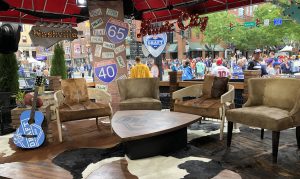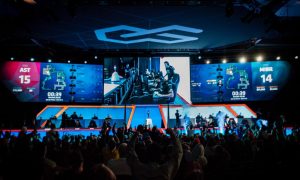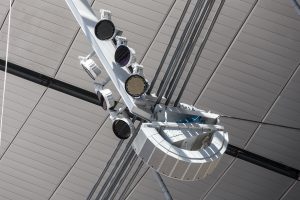2019 in Review: Trends in Audio Continued, Esports Exploded
Standards, in-venue sound, immersive stayed the course of growth
Story Highlights
The year in sound was generally one of continuing trends in all its applications — particularly in spectrum reallocation, live sound, immersive audio. One exception was esports, which become a commercially competitive sport and saw dedicated mega venues open during the year.
Broadcast Audio
There were no spectrum disruptions this year. Instead, there was more push into alternative neighboring frequencies in search of open bandwidth. On the other hand, fallout from the spectrum reallocations left many wireless users in the lurch for frequency coordination.
“The system of database administrators collapsed,” said Joe Ciaudelli, director, spectrum affairs, Sennheiser. “Professional mic operators currently lack an official resource that they can easily and confidently check for channel availability and register for interference protection.”
Mostly, broadcast audio built on previous trends. Development of such standards as the SMPTE ST 2110 suite continued, and multichannel sound pushed beyond 5.1 channels to embrace 7.1.4, if only tentatively for now. But it was still a busy year for ears.
Esports
The esports phenomenon continued to gain momentum, expected to reach more than $1 billion in revenue this year and to triple over the next five years. With a growing fan base of more than 450 million viewers globally, this gaming revolution has become as much a “sport” as football and basketball. Esports Stadium Arlington and Full Sail University’s Fortress had opened their mega venues for videogaming, and more commercial (Comcast’s $50 million venue for its Fusion team) and collegiate (University of Washington, Ohio State University, and University of North Texas) venues are built.
What sets esports apart from conventional sports at a very fundamental level is that, aside from crowd noise, all of its sound must be artificially created. Unlike traditional broadcast sports, for which microphones and other transducers capture a game’s natural sounds, esports’ audio comprises electronically generated sound effects. Videogames have already made an art form of their audio, with their own industry awards and recognition. Now that esports has become commercially competitive, its audio will continue to expand its own sonic universe.
Live Sound
Similarly, as conventional sports become more of a pure entertainment play, their live sound becomes increasingly important. Louder, clearer, a bigger bottom — those have become the key criteria for live-sound systems in sports venues in recent years, as venues have become larger and fans in stands have become accustomed to — and often demand — ever-higher SPL.
Music-touring sound systems have become the gold standard for stadiums and arenas, as sports venues increasingly are part of larger “destination” entertainment campuses. Avenida Houston, for example, hosts the MLB Astros’ Minute Maid Park, the MLS Dynamos’ BBVA Compass Stadium, and the NFL Texans’ NRG Stadium, and the Atlanta Braves’ new SunTrust Park at the Battery Atlanta also houses the Coca-Cola Roxy music venue and shopping, dining, and office space.
In 2019, sports venues accommodated a large number of “rider-friendly” or “rider-ready” PA systems, those widely accepted by top-tier touring music artists, who list them on their contract addenda (or “riders”).
American football has invaded overseas markets, and so are U.S.-inspired venue-AV designs. That was illustrated this year with the opening of the Tottenham Hotspurs’ “super” stadium in London, a facility that would be at home in any major U.S. city and throughout which 4,500 JBL speakers of various types were installed. The speakers range from the 18 VLA-C weatherized compact line arrays that ring the bowl, a design derived from JBL’s concert-touring VTX series speakers and intended to connect with touring sound systems, to the CBT columnar speakers in back-of-house areas. Appropriately, given current trends, the audio consultant on the project was Joe O’Herlihy, longtime audio director and live-sound engineer for U2.
Going Deep
Immersive audio inched toward to the mainstream in 2019. NBC Sports capped two full years of Dolby Atmos immersive audio on all Notre Dame Football home games for DirecTV customers, and the National Hot Rod Association (NHRA) continued a three-year trial of Atmos for regular-season and finals races. The 7.1.4 format is expected to play a large role in the 2020 Tokyo Olympics next summer.
Miked Up
2019 saw on-player audio become more norm than novelty. For instance, for the Coors Light NHL Stadium Series game between the Pittsburgh Penguins and Philadelphia Flyers, NBC Sports wired four players per team, as well as both coaches and two referees, for sound, and some of the dozen audio sources from the live broadcast were used for an hour-long special broadcast later.
“I can’t remember having personal mics on this many athletes in a game before,” said Karl Malone, director, sound design, NBC Olympics and Sports, at the time. “It would be difficult for many reasons to mix the 12 mics live; you would miss conversations perhaps on iso-camera records that would have been good to hear. We also need to protect the privacy of the athlete. That’s why we are building a whole hour-long show around the content we get in this game.”
Education
What may have hit some headwinds during the year was pro-audio education. “The smaller schools we work with don’t touch it,” educational marketing consultancy Sonority Group’s Chris Davie, former head of operations, School of Audio Education (SAE), said of the state of broadcast-audio learning. “The state schools that already have a well-developed communications department and do film and television [and] teach the technology side of broadcasting, including audio. But, if the infrastructure isn’t already there, it’s too much of a stretch for most schools.”
Part of the problem? “Television is meaningless” to Gen Z-age students, Davie explained. However, such institutions as Full Sail University and the Conservatory of Recording Arts & Sciences (CRAS) continue to make significant investments in broadcast-sound infrastructure and to promote curricula around them.

For the NFL Draft, ESPN deployed close to 100 microphones across a 15-block campus in Nashville, including the Rock Bottom Brewery.
Who Needs a Game?
Expect sports to field more events with concert-level AV, even those not connected to a game. ESPN deployed close to 100 microphones for the NFL Draft in Nashville, which drew more than 300,000 attendees, the biggest NFL Draft event ever, across a 15-block campus from downtown Nashville to Nissan Stadium across the Cumberland River. It made Super Bowl look small.
Music Costs Money
Broadcast-sports leagues’ assertion of their copyrights are well-known, but the provenance of music used for some of those shows is often less clear. College social-media accounts, which have long used sports as part of new-student recruitment, this year drew the ire of and, increasingly, legal action by music publishers, who contend that copyrighted music tracks are illegally used as part of online campaigns. Twitter accounts, including @AuburnFootball and Rutgers’ @RFootball, were removed after Digital Millennium Copyright Act (DCMA) takedown notices were filed by copyright holders. Similar actions have been reported against Alabama, North Carolina State, and the University of Georgia Atlanta. The action has extended in at least one case to the major leagues as well, with the Houston Rockets’ Twitter account suspended temporarily. The alleged infringements had been tolerated for some time by music publishers, who derive significant royalties from sports networks for live and broadcast copyright uses through such agencies as ASCAP and BMI. That forbearance came to an end this year.
Music’s importance to televised sports was underscored by the partnership between rapper/entrepreneur Jay-Z’s Roc Nation company and the NFL. Roc Nation will be the NFL’s “live-music entertainment strategist,” consulting on the league’s entertainment offerings, including the Super Bowl Halftime Show and the NFL Draft, and on the its social-activism campaign. And just as music venues have been accommodating changes in musical genres and styles, the new Jay-Z/NFL deal will have the same effect on football stadiums.
“Sound systems in sports venues have been becoming more hi-fi for music for a number of years, but the recent ascendancy of hip-hop in pop music has changed everything,” says Paul Murdich, GM, TSI-Global, whose sports portfolio includes Busch Stadium. That’s manifest mainly, he says, in the form of additional subwoofers added to line-array systems.
Climate Change
Weather affects everything, and, as more audio and video systems are installed into ever-larger outdoor sports stadiums, weather — more specifically, more of it — is going to play a part in PA-system decisions.
“We’ve had water-resistant products in the past, but it’s definitely been getting wetter out there,” said Aaron Niemann, sales manager, Mid-Atlantic territory, Bose Professional. “Integrators that work on outdoor sports venues have been telling us that they want [speaker] boxes that can stand up to the elements as they become more intense.”
Technomad VP Rodger Von Kries concurred: “There’s no doubt that the demand is growing for weather-resistant and weatherproof sound systems and [related] elements. The market for that kind of product just keeps growing.”
Best News Story of the Year for Sound
2017 World Series champion Houston Astros were caught this season using a sophisticated video feed to steal opposing catchers’ signs during home games. But the method they used to communicate the purloined signals would have been familiar to the Boston Red Sox playing their first game in 1901: they banged on a trash can just outside the entrance to the dugout, two raps indicating that a change-up was on the way. At a time when broadcast audio is on the cusp of moving to 12 channels, the Astros are solidly in the “Back to Mono” camp.


